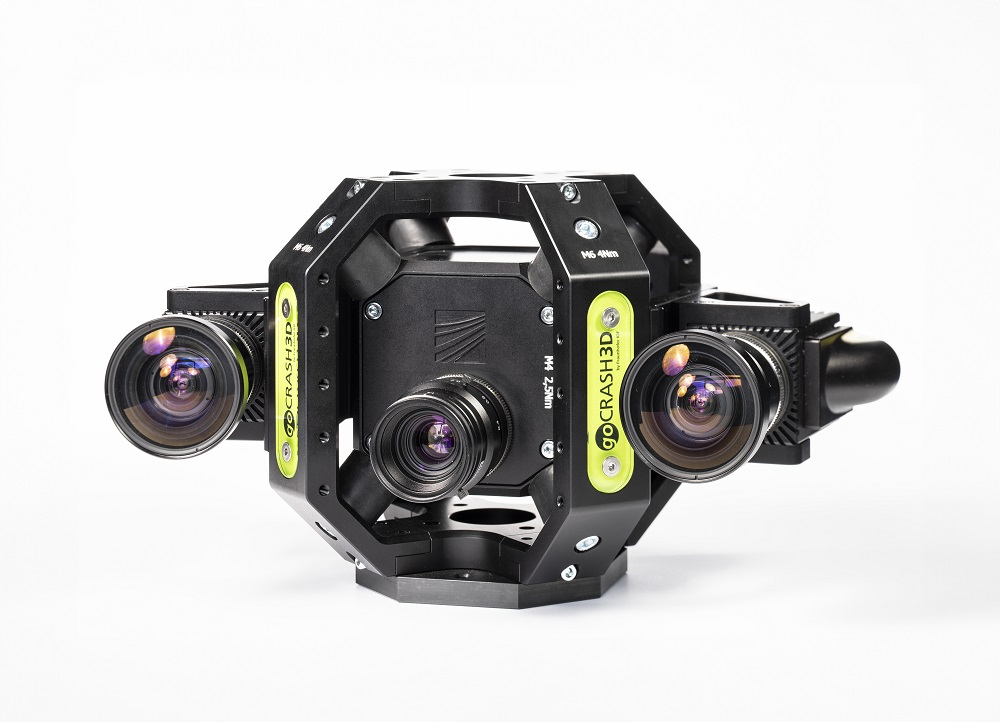New measurement technology allows high-speed 3D recordings in the vehicle interior during a crash test for the first time
The 3D Sensor That Survives the Crash Test
The Fraunhofer Institute for Applied Optics and Precision Engineering IOF has been developing systems for the high-speed capture of 3D data for many years. With goCRASH3D, the Jena team is now presenting a new system that records 3D data during crash tests inside the test vehicle. It shows the deformation and movement of vehicle components during a collision in a way that was previously not possible or only possible to a limited extent. goCRASH3D will be exhibited at the VISION and IZB trade fairs.
For more than ten years, Fraunhofer IOF in Jena has been working on capturing 3D data with high-speed cameras. Essentially, such a system consists of two cameras, a projector and a computer. “The crux of the matter is not actually the camera, but the lighting,” explains project manager Kevin Srokos. The researchers in Jena further developed the GOBO technology from stage technology for their purposes years ago.
With the GOBO technology, a disk with an irregular fringe pattern rotates in front of a high-power light source. This produces a non-periodic sinusoidal pattern on the object to be measured. This allows points in the images from the cameras looking at the object from different angles to be matched. The 3D coordinates for the points in the images are calculated from the position of the cameras and the offset of the image points.
Application in the automotive sector
The Jena team tested their system in the automotive industry very early on. “Back then, the system was used to track the deployment of an airbag with time resolution,” reports Srokos. “But back in 2017, we also had the idea of moving the system into the interior of the vehicle.” In a joint project with a major German car manufacturer, the Jena team set up a demonstrator for this purpose, which has been used for tests by the project partner since 2023.
With goCRASH3D, it is possible to observe processes in the footwell, for example, that were previously inaccessible or only accessible to a very limited extent. Areas obscured by the deploying airbag can also be tracked in this way.
The technology in detail
When using goCRASH3D in the vehicle, the lighting once again plays the main role: “The shorter the exposure time, the stronger the lighting needs to be,” says Srokos. In this specific case, a single LED with 15,000 lux luminosity is used. The two cameras each deliver 12,000 images per second with 512 x 512 pixels. From this, the computer calculates around 1,200 3D images per second. The field of view in the experiments was 70 x 70 cm² at a distance of one meter. These parameters can be adapted to the experiments.
The system with two cameras and the projection unit is mounted in a frame in which the components are protected against acceleration by elastomer buffers. This enables the system to withstand accelerations of up to 200g and shocks of up to 60g on a regular basis. The frame is permanently mounted in the vehicle for this purpose.
High-speed recordings today and tomorrow
The goCRASH3D system is currently being used by the project partner and further developed at Fraunhofer IOF. At the institute in Jena, the high-speed recordings have already been coupled with other cameras so that the 3D images can be combined with additional spectral information.
The goCRASH3D system was developed for and with the automotive industry. “However, we can also imagine other applications in the safety sector or in sports medicine,” explains Kevin Srokos. In the medium term, the technology for 3D high-speed recordings is an excellent solution for the growing safety requirements in the automotive sector.
Presentation at the IZB and the VISION 2024
The Fraunhofer IOF team will be presenting the goCRASH3D system from October 8 to 10 at VISION in Stuttgart (booth no. 10G92) and at the IZB in Wolfsburg from October 22 to 24 (hall 2, booth 2201).
This 3D animation shows the application of goCRASH3D in a crash test hall in a test vehicle. © Fraunhofer IOF


